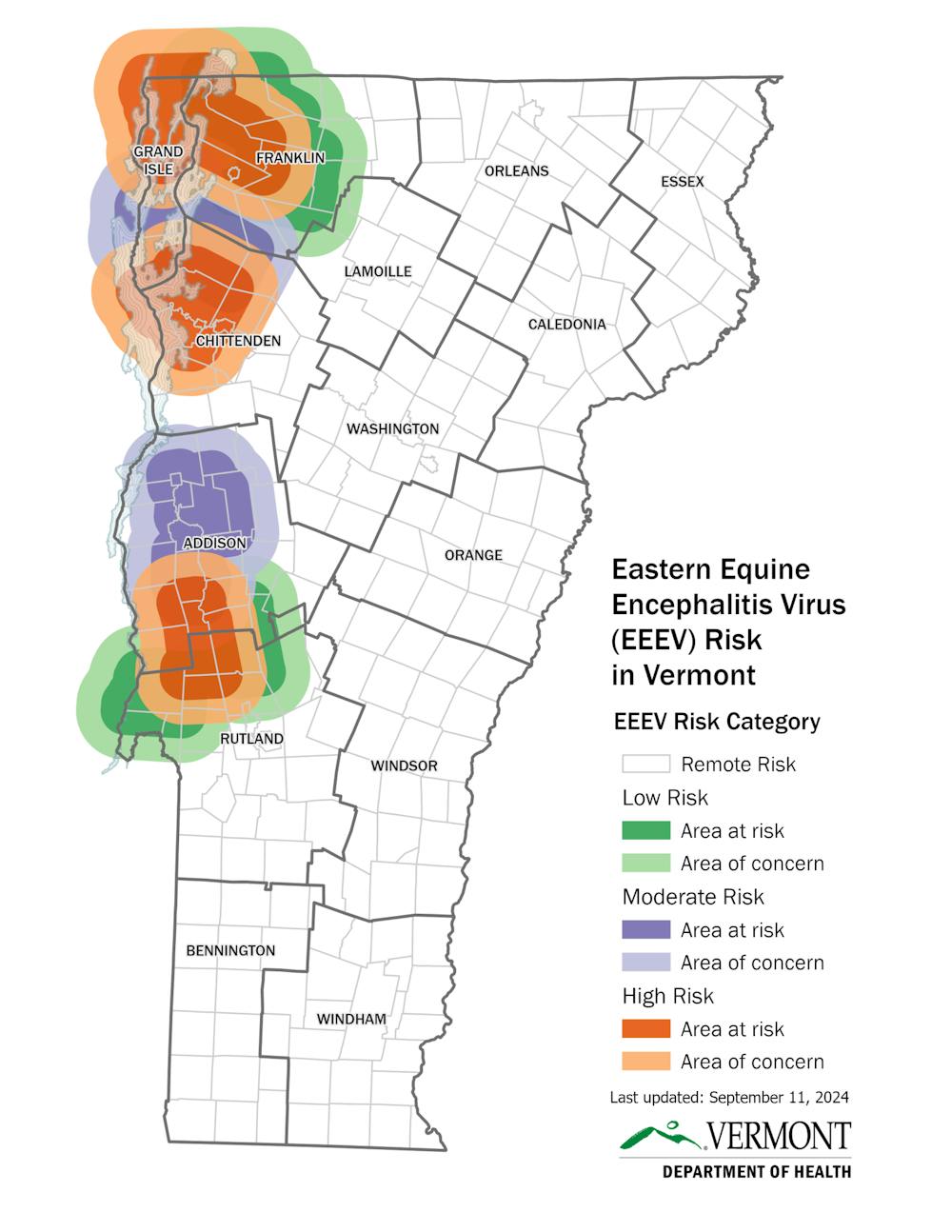College Physician and Chief Health Officer Mark Peluso notified community members about the proliferation and potential dangers of mosquitoes carrying Eastern Equine Encephalitis (EEE) in Addison County in an email to the college community on Sept. 5. While Middlebury is not currently classified as an area of moderate or high risk, neighboring towns like Vergennes and Cornwall have been designated a moderate risk. Other towns in Vermont such as Sudbury, Colchester and Burlington have been deemed high risk areas.
In the message, Peluso explained that the risk of EEE in non-infected mosquito populations is nearly zero. In infected mosquito populations, the risk of severe infection remains low but still necessitates notifying communities that may be affected. The Center for Disease Control (CDC) considers EEE a rare disease — cases vary in severity, but only a few instances of the disease are reported every year. Peluso also noted that the CDC reports that most people infected with EEE develop no symptoms. However, in August, the Vermont Department of Health reported the first case of EEE in Vermont since 2012 in a man from Chittenden County.
People who do develop symptoms sometimes experience fever, chills, body aches or joint pain, according to Peluso. Symptoms usually last one or two weeks, and most recover completely when there are no central nervous system interactions.
“Approximately 5% of individuals with EEE symptoms can develop neurologic disease involving the brain (encephalitis and meningitis). These individuals can have fever, headaches, vomiting, diarrhea, seizures, behavioral changes, drowsiness, and coma. Approximately 30% of the subset of people who develop severe EEE die from the illness, and many survivors have ongoing neurologic problems. Treatment is supportive care, typically in a hospital intensive care unit. There is no vaccine for EEE, ” Peluso wrote.
Despite these statistics, most people do not contract severe infections from mosquito bites. In an email to The Campus, Emily Pareles, an epidemiologist from the Vermont Department of Health, provided tips to prevent contracting this disease.
In the email, Pareles advised limiting time outdoors, wearing long sleeves to reduce skin exposure and using an EPA-approved insect repellent, among other measures.
Pareles also emphasized the importance of removing pools of stagnant water near living spaces.
“It’s important to control mosquitoes at home. Mosquitoes breed in standing water that lasts more than four days. To reduce the number of mosquitoes around your house, get rid of standing water,” Pareles wrote.
She noted that the guidance on avoiding the outdoors will remain in place until the first hard frost of the winter season, which kills mosquitoes until the following spring.
According to Pareles, Vermont is not the only state plagued by EEE-infected mosquitoes. She noted that there have been cases of EEE reported in Massachusetts, Rhode Island and New Hampshire. New York state specifically reported 12 infected horses across 10 different counties.
Emerson Kington ’28 shared that he appreciated the communication from the Center for Health and Wellness (CHW) and the ways in which they provided solutions and steps to prevent EEE infection.
“I understand the risks now, and I think the health center did a good job of laying out possible solutions, and preventative measures,” Kington said.
Prior to coming to campus, Kington had not necessarily considered the possibility of encountering mosquito-borne illness, but remembers hearing about similar outbreaks in the past.
“I of course remember when Zika virus was circulating, and some of the other dangers with diseases like the West Nile Virus, and malaria, but I didn’t really know a lot about EEE specifically,” Kington said.
Other students echoed that same appreciation for the message. Skye Sobel ’28 explained that specificity of the safety measures was helpful in reducing some of her concerns in regards to contracting EEE.
“Just giving us all the information we needed to make informed decisions [was helpful]. And, also providing us [with] some possible solutions, like wearing long sleeves and pants, and obviously wearing bug spray and stuff like that,” Sobel said. “I think having the health center just be on top of things and being super informed about the local issues in the area is helpful, and I feel better that they can provide us with good data.”




